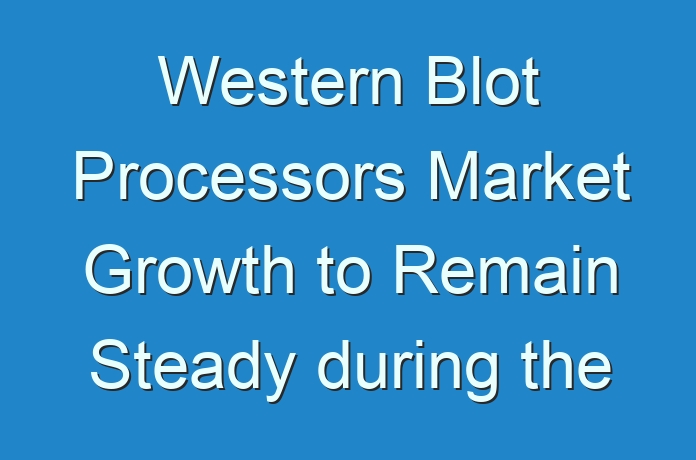
Western blot, also known as immunoblot, is a laboratory bio-analytical method employed to detect specific protein molecules from a complex mixture of protein samples. The western blotting method is widely used in the cell & molecular biology discipline to detect proteins of interest and to quantify a gene product in gene expression studies. This method is also applied to measure the size and amount of protein expression. This method basically involves three major steps: separation of protein molecules by size, transfer of proteins to the solid membrane, and marking the desired protein using primary and secondary antibodies for visualization. High sensitivity and specificity are two key advantages offered by western blot methods. By using this method, a researcher can detect desired protein even with a concentration ten times lower limit of detection. Western blot processors are available in two different types: semi-automatic and fully automated. The manual western blot processing is time-consuming and labor-intensive, which generates the demand for automated western blot processors. Western blot processors offer several benefits. These processors automate all steps of membrane processing; they can process multiple membranes simultaneously; automatically collect primary antibodies; and effectively mix reagents inside trays.
Request Brochure for Report – https://www.transparencymarketresearch.com/sample/sample.php?flag=B&rep_id=31526
The global western blot processors market is projected to expand significantly in the next few years, owing to factors such as increasing prevalence of HIV/AIDS across the globe, growing use of the western blot method in proteomics and genetic science, and rising R&D budgets of pharmaceutical and biotechnology companies. Also, the western blot method is employed to confirm the hepatitis B infection and for the diagnosis of Lyme disease. The increasing prevalence of these diseases is anticipated to drive the western blot processors market during the forecast period. However, factors such as high cost of automated western blot processors and possibility of obtaining false or subjective results are anticipated to restrain the western blot processors market in the near future.
Request for Analysis of COVID19 Impact on Western Blot Processors Market –
https://www.transparencymarketresearch.com/sample/sample.php?flag=covid19&rep_id=31526
The global western blot processors market can be segmented based on type, end–user, and geography. Based on type, the market has been segmented into semi-automated and automated western blot processors. The semi-automated western blot processors segment dominated the market in 2016, but it is likely to lose market share to the automated western blot processors segment by 2025. The automated segment is projected to expand at a significant growth rate during the forecast period, owing to rising inclination toward laboratory automation and increasing laboratory workflow. Based on end–user, the global western blot processors market has been segmented into hospitals & diagnostic centers, pharmaceutical & biotechnology companies, and academic & research institutes. The hospitals & diagnostic centers segment accounted for a leading market share in 2016 and is projected to gain market share by 2025. Growth of the segment is attributable to rising incidence of HIV/AIDS and increasing number of and demand for hospitals and diagnostic centers in developing countries.
Pre book Market Report –
https://www.transparencymarketresearch.com/checkout.php?rep_id=31526<ype=S
Geographically, the global western blot processors market has been segregated into North America, Europe, Asia Pacific, Latin America, and Middle East & Africa. North America dominated the global market in 2016 and is anticipated to lose market share to Europe and Asia Pacific between 2017 and 2025. Europe followed North America in 2016, holding the second-largest share of the market. The market in Asia Pacific is projected to expand at the maximum CAGR during the forecast period, due to increasing health care budgets and rising investments in the biopharmaceutical sector in emerging economies such as India, China, and Malaysia. Also, rising incidence of HIV/AIDS in this region would propel the demand for western blot processors in Asia Pacific during the forecast period. According to avert.org, in 2016, more than 5.1 million people were living with HIV/AIDS and more than 270,000 new cases of HIV infection were diagnosed in Asia Pacific.
Ask for Discount :
https://www.transparencymarketresearch.com/sample/sample.php?flag=D&rep_id=31526
Key players operating in the global western blot processors market are GE Healthcare, PerkinElmer, Inc., Merck Millipore, Thermo Fisher Scientific, Inc., Li-Cor Biosciences, Bio-Rad Laboratories, Inc., Advansta Inc., Cytoskeleton, Inc., Bee Robotics Ltd., and Trinity Biotech plc.
About Us
Transparency Market Research is a global market intelligence company providing global business information reports and services. Our exclusive blend of quantitative forecasting and trends analysis provides forward-looking insight for several decision makers. Our experienced team of analysts, researchers, and consultants use proprietary data sources and various tools and techniques to gather and analyze information.
Our data repository is continuously updated and revised by a team of research experts so that it always reflects latest trends and information. With a broad research and analysis capability, Transparency Market Research employs rigorous primary and secondary research techniques in developing distinctive data sets and research material for business reports.
Contact
Transparency Market Research,
90 State Street, Suite 700,
Albany, NY 12207
Tel: +1-518-618-1030
USA – Canada Toll Free: 866-552-3453





